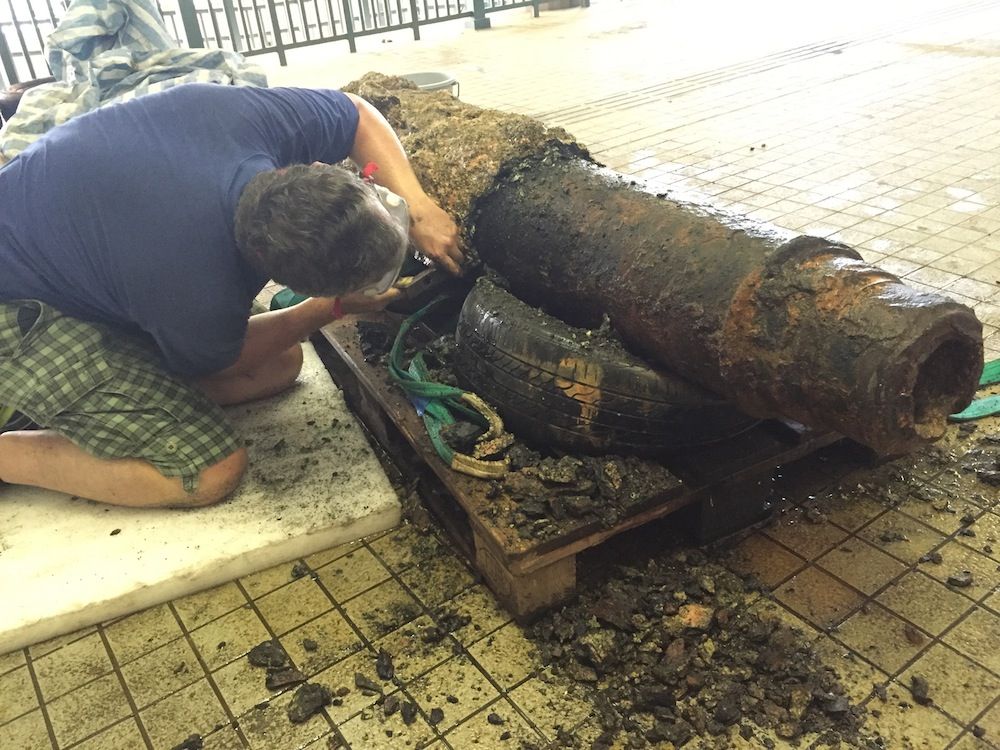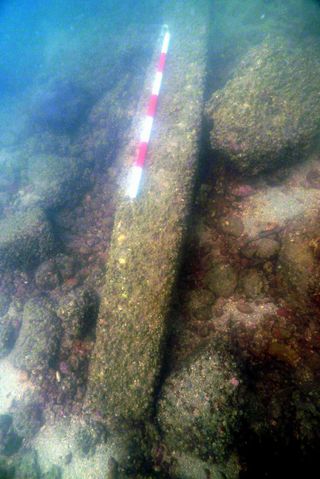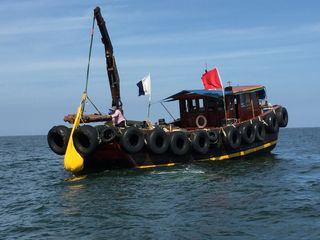Divers Recover Hong Kong’s Oldest Maritime Artifact

In the waters around Hong Kong, divers recently recovered a 1,000-year-old granite anchor stock — the oldest maritime artifact ever found in the Chinese territory — and a European-made cannon from the early 19th century, which may have been used on a merchant ship to defend against pirates, according to archaeologists.
The recent discoveries hint that a trove of undiscovered relics could lurk beneath the waves of the harbor city.
"We see this as the tip of the iceberg," dive expedition leader Bill Jeffery, an archaeologist with the Hong Kong Underwater Heritage Group, told Live Science. "The Hong Kong SAR [Special Administrative Region] is 60 percent water, and yet nearly no archaeology has been done underwater here." [See Photos of the Seafaring Relics Found in Hong Kong's Waters]
The 6-foot-long (1.8 meters) granite stock — the upper crosspiece found on some anchors — was recovered from the seabed, beneath about 10 feet (3 m) of water, near the base of a cliff on Hong Kong's High Island.
It is the same style and material as anchor stocks used during China's Song Dynasty, which lasted from A.D. 960 to 1279, according to Encyclopedia Britannica. An anchor stock that dates back to the Song Dynasty is on display at the Maritime Silk Road Museum of Guangdong in Yangjiang, located about 200 miles (320 kilometers) southwest of Hong Kong, on the Chinese mainland.
Jeffery, a professor in the anthropology department at Guam University and a research associate at the Hong Kong Maritime Museum, said he was able to recognize the anchor stock during an initial dive at the High Island site because he had seen the one on display in Yangjiang.
“It just stood out from the rest of the natural rocks: you can tell it is man-made, with straight lines, and really nicely formed,” he said.
Sign up for the Live Science daily newsletter now
Get the world’s most fascinating discoveries delivered straight to your inbox.
Anchors aweigh

Originally, the granite anchor stock would have been attached to a wooden shaft measuring between 6 and 10 feet (1.8 and 3 m) long, with wooden flukes designed to dig into the seabed, Jeffery said.
"We know that ships in the Song Dynasty used these types of anchors, although it could be from the Yuan Dynasty [A.D. 1271 to 1368] that came after," he said.
"In the Ming Dynasty [A.D. 1368 to 1644], the anchor changed to a very different shape — more like a [grappling hook] made of iron, because they were getting the technology to make larger objects out of iron," Jeffrey said.
He added that the anchor stock may be from one of the Chinese merchant vessels of the Song period that sailed south to trade in Hong Kong and the cities of the mainland near the Pearl River Delta. [Shipwrecks Gallery: Secrets of the Deep]
"People would have been trading up and down the Chinese coast and coming into the Pearl River, at least from the time of the Tang Dynasty [A.D. 618 to 907]. This anchor could be from a vessel that was trading over a long distance, or from a vessel connecting with larger ships to carry cargo [to and from the coast]," Jeffery said.
There is no sign of a shipwreck near the anchor stock, but broken pieces of pottery were found on the seabed nearby, Jeffrey said. He thinks these fragments date to sometime after the 17th century, which suggests the site may have been used as a temporary anchorage for many centuries, he said.
"They would be sleeping, cooking and living aboard, and so they'd carry pottery," Jeffery said. "All of the stuff we've seen is broken, probably washed overboard, or it was broken and then thrown overboard."
Protection from pirates
In a second recovery effort in July, a team of seven divers made 25 dives over two days to raise a cannon from the seabed just off the coast of Hong Kong's Basalt Island. The 1-ton, 6-foot-long (1.8 m) ship's gun is of a style called a "cannonade," or "gunnade," which is shorter and lighter than a standard 24-pound (11 kilograms) naval "long gun," Jeffery said.

An early inspection found identification marks — the letters "ECL" and a British crown — inscribed on the 1-ton barrel by the foundry that made it, he said. [The 7 Most Mysterious Archaeological Finds on Earth]
Similar marks have been found on early 19th-century European cannons discovered in India, Japan and New Zealand, which could indicate they were made by a small foundry somewhere within the British Empire.
Because the cannons used by European navies were usually made by well-known foundries, it's likely the cannon found in Hong Kong was used on a merchant vessel, possibly as a defense against the pirates who menaced the waters around Hong Kong until the mid-19th century, Jeffrey said.
On a future expedition, the researchers from the Hong Kong Underwater Heritage Group hope to recover a second, smaller gun that was among the rocks of the seabed beneath the recently recovered cannon.
"We didn't get that because we ran out of time, but that will be interesting to bring up, because it's another piece of the jigsaw puzzle of this site," Jeffery said.
Underwater and undiscovered
After up to two years of conservation work to remove centuries of built-up sediment, the researchers hope both cannons and the anchor stock will go on display at the Hong Kong Maritime History Museum, which sponsored the archaeological dives under licenses issued by the Hong Kong government.
Jeffery said that underwater archaeology in Hong Kong has been "very overlooked" so far. "Lots of archeology in Hong Kong has been done on land but they stop at the waterline, so really nothing's been done underwater."
Later this year, from Nov. 27 to Dec. 2, the Hong Kong Maritime Museum will host the third Asia Pacific Conference on Underwater Cultural Heritage.
"We hope that this may help to stimulate things in Hong Kong as well as Asia-Pacific in general," Jeffery said. "Hong Kong has 236 islands, so potentially there are a lot of shipwreck sites and other types of sites, perhaps even prehistoric sites, around the islands and along the coastline."
Original article on Live Science.
Tom Metcalfe is a freelance journalist and regular Live Science contributor who is based in London in the United Kingdom. Tom writes mainly about science, space, archaeology, the Earth and the oceans. He has also written for the BBC, NBC News, National Geographic, Scientific American, Air & Space, and many others.












